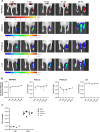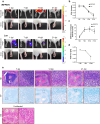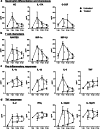In vivo imaging identified efficient antimicrobial treatment against Mycobacterium marinum infection in mouse footpads
- PMID: 39420066
- PMCID: PMC11487254
- DOI: 10.1038/s41598-024-75207-5
In vivo imaging identified efficient antimicrobial treatment against Mycobacterium marinum infection in mouse footpads
Abstract
Mycobacterium marinum (M. marinum) is the most common causative bacteria of cutaneous non-tuberculous mycobacterial (NTM) infections, including fish tank granuloma. Treating M. marinum-caused infection takes longer than other NTM diseases because M. marinum is less susceptible to antimicrobial agents. A standard treatment regimen for M. marinum infection has not been established yet, and few in vivo experiments have been performed in mammals to evaluate the bactericidal effects of antimicrobials. In this study, we developed a noninvasive in vivo imaging method to assess the therapeutic efficacy of antimicrobials against M. marinum infection. The data obtained using fluorescent protein or bioluminescence from luciferase will offer valuable insights into bacteria visualization across various bacterial infections. Furthermore, through this imaging technique, we demonstrated that combining clarithromycin, rifampicin, ethambutol, and minocycline effectively cleared M. marinum from the footpad. Granulomas with necrotic abscesses formed on the footpad of M. marinum-infected mice, primarily due to neutrophils involved in the host's cell-mediated immune response. Inflammatory cytokine and chemokine levels significantly increased 7 days post-infection, aligning with the footpad swelling and granuloma formation observed in the untreated group. Interestingly, immune mediators and cells induced by M. marinum footpad infection were crucial factors associated with hypersensitivity and granuloma formation, as seen in pulmonary tuberculosis. This novel imaging analysis using a cutaneous NTM mouse model might be a powerful tool for the comprehensive analysis of mycobacterial infections.
© 2024. The Author(s).
Conflict of interest statement
The authors declare no competing interests.
Figures




References
-
- Schlossberg, D. Tuberculosis and Nontuberculous Mycobacterial Infections. Vol. 6th editionAmerican Society for Microbiology, (2011).
-
- Aronson, J. D. Spontaneous tuberculosis in Salt Water Fish. J. Infect. Dis.39, 315–320. 10.1093/infdis/39.4.315 (1926).
-
- Linell, F. & Norden, A. Mycobacterium Balnei, a new acid-fast bacillus occurring in swimming pools and capable of producing skin lesions in humans. Acta Tuberculosea Scand.33, 1–84 (1954). - PubMed
-
- Ang, P., Rattana-Apiromyakij, N. & Goh, C. L. Retrospective study of Mycobacterium marinum skin infections. Int. J. Dermatol.39, 343–347. 10.1046/j.1365-4362.2000.00916.x (2000). - PubMed
-
- Sia, T. Y. et al. Clinical and Pathological Evaluation of Mycobacterium marinum Group Skin Infections Associated with Fish Markets in New York City. Clin. Infect. Diseases: Official Publication Infect. Dis. Soc. Am.62, 590–595. 10.1093/cid/civ937 (2016). - PubMed
MeSH terms
Substances
Supplementary concepts
Grants and funding
LinkOut - more resources
Full Text Sources
Medical
Molecular Biology Databases
Research Materials

